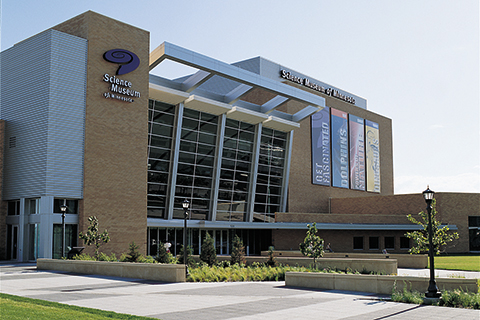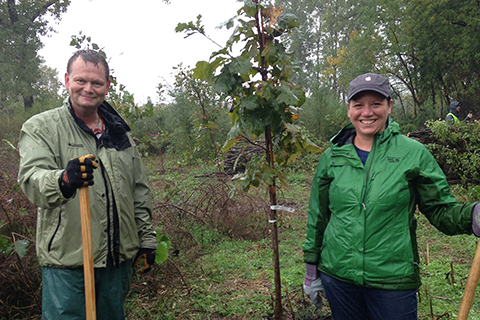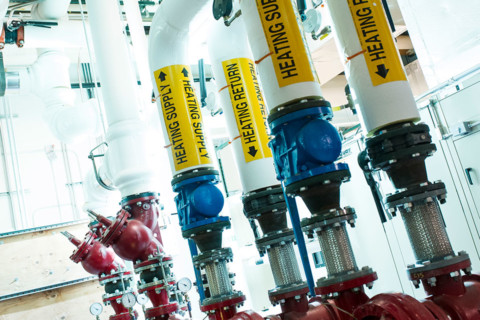District Energy St. Paul is committed to environmental stewardship, use of renewable resources, and energy-efficient systems, such as chilled water storage, biomass-fired combined heat and power (CHP), and solar thermal. Furthermore, our teams working in the plant and distribution system strive to achieve optimal system efficiencies to reduce fuel inputs needed to serve our customers.
Our System Making Your Building Greener
District Energy is a recognized leader in environmental and energy sustainability for the entire nation, earning a Global Sustainability award from the International Energy Agency and recognition from the United Nations Environment Programme. Our mission is to be the preferred provider of community energy services that benefit our customers, the community, and the environment. As a loyal customer and community partner, we appreciate your shared commitment to sustainability and hope we can continue to work together to make Saint Paul the most livable (and green) city in America.
- District Energy St. Paul is the largest hot water urban district heating system in the US, which leads the industry in technology integration targeted to improve the efficiency and environmental profile of the system and its users.
- The integration of combined heat and power for the system allows two energy products (heat and electricity) to be generated from a single source, increasing fuel efficiency, reducing costs for end users, and reducing carbon profiles in both energy sectors.
- District Energy St. Paul utilizes waste heat from a biomass-fueled combined heat and power (CHP) plant, which serves as the primary heating source for the downtown system. The tree waste used to supply the systems comes from tree trimmings, invasive species removal (including EAB), storm damage, construction debris and pallets, land-clearing, understory thinning and habitat restoration, and forest residuals. By collecting tree waste, District Energy helps communities with their management of these residuals and turns a waste product into a renewable source of electricity and heat. We focus on collecting most of our biomass from a 60 mile radius of the plant to keep things as local as possible and manage our transportation inputs. District Energy’s CHP plant uses wood residuals as primary feedstock, supplying up to 90% of the fuel needed to produce approximately 25 MW of electricity for the grid and 55 MW of heat for District Energy customers. On average, the hot water supplied for your heating system is 40-50% renewable and carbon-free. We avoid approximately 80,000 tons of carbon per year through biomass-driven combined heat and power.
- District Energy St. Paul has committed to becoming carbon neutral by 2050. The organization has already made notable progress on carbon reduction targets over the years, reducing carbon emissions by 77% between 2000 and 2023 and eliminated coal from the fuel supply in 2019. To achieve regular reductions, District Energy has an aspirational goal of 7% reductions each year, based on a commitment to efficiency improvements in production, distribution, and customer buildings. This target was set to emphasize the recommendations from the United Nations Environment Programme to reduce greenhouse gas emissions by 7.6 % each year between 2020 and 2030.
- In 2010, we added the nation’s largest solar hot water installation atop the Saint Paul RiverCentre. The carbon footprint from the high-performance solar thermal installation resulted in carbon emission reductions of approximately 460,000 pounds per year.
- Being connected to District Energy St. Paul means being connected to our sustainability and energy literacy education programming.
- The cooling system has also reduced our customer’s environmental profile. The integration of district cooling significantly reduced the use of chlorofluorocarbon (CFC) refrigerants in customer buildings and has reduced peak electricity usage through the incorporation of thermal storage.
- The system utilizes a fiber optic meter data collection system that is one of the most advanced in the industry. This system provides District Energy with data to enable its customer service team to help optimize building performance and provide customers with their energy trend information through the District Energy St. Customer Portal. The portal links to Energy Star for ease of data upload for benchmarking and meeting the City of Saint Paul requirements.
- District Energy’s engineers visit customer buildings and consult with property managers to evaluate opportunities for improved energy efficiency of equipment associated with the distribution of hot and chilled water throughout a building. The engineers also depend on the distribution system’s performance tracking to identify building connections that may be in need of repair or replacement. These efforts not only enhance and maintain the distribution system’s efficiency but they help the building manager maintain a high performing building.
- Being connected to District Energy St. Paul helps our customers meet the requirements for LEED, Green Communities, B3, Green Globes, Energy Star, and other certifications. Our efficiency and renewable profile helps customers qualify, without needing to manage an entire energy plant in their building. Customers can apply for energy efficiency project support though our energy efficiency program.
- District Energy St. Paul is one of the first district systems in the US to provide carbon-neutral cooling to all of its cooling customers. In partnership with Minnesota-based clean energy solutions provider Zero6 Energy, District Energy purchased renewable energy credits (RECs) from local renewable energy projects in Minnesota and Wisconsin to make this goal a reality. The RECs mitigate the greenhouse gas emissions from electricity and are tracked by a third-party entity to ensure accuracy. Going forward, this agreement will offset District Energy customers’ scope 2 emissions associated with electricity used to deliver chilled water to customer buildings.



